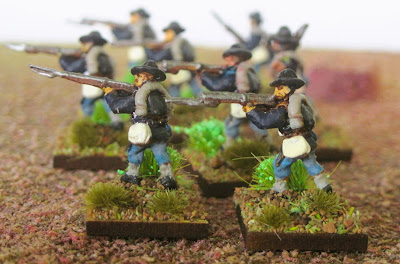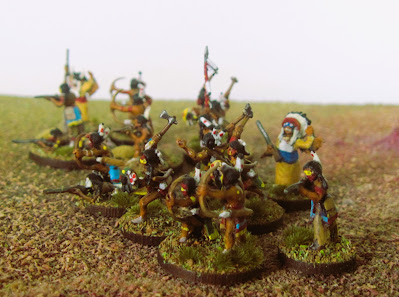My HQ Detachment is loosely modelled on that of Crook on the Powder River and Rosebud Expeditions. Let us look at progress on the various elements. They all offer interesting gaming opportunities. Be advised, this started off as a single post. I realised it would take two posts and cut it. Hopefully it still reads well enough
Above, we have
the Great Man himself, the General. He
was normally accompanied by an Adjutant(s) and the vital Indian Scouts. Numbers of the latter could vary. Note the scouts are wearing red. This is so Crook's soldiers can recognise them as allies. Unfortunately, red was a favourite colour of the Sioux and Cheyenne too! An ahh.. moment for Crook.
While we are on Scouts here is a photo of Arikara and Crow Scouts. No one makes Arikara (Rees) in 15mm.
I think it was
taken at the site of the Little Big Horn battle. We have discussed tribal hair styles before
and here we see how distinctive they could be.
The Arikara (Rees) have a top knot or tuft, the Crow a quiff and plaits.
Horses, Mules
and Men had to be fed. Reserve ammunition was essential. Crook was a mule enthusiast. They were tough and highly mobile. So were the Packers and Crook loved them too. All the same mules lacked capacity and the
more you took the more Packers were needed.
Packers had to be fed too and so did extra Mules.
Here's another thing about Packers-they were incredibly well paid. They earned more in a week than a trooper did in a month. Lots more.
Finerty, a journalist accompanying Crook chose to Mess with the Packers. Crook invited him to dine. "Ah, no thank you General said Finerty, previous engagement!" The Packers dined well. Custer famously used soldiers as Packers. It saved a fortune. His packs never showed up.
The solution
was the wagon. Not so mobile but
roomy. Mules could accompany a detached
Battalion or Company. Wagons stayed with
the HQ.
As an expedition progressed the
contents of the wagon would be consumed.
This resulted in capacity for carrying the wounded.
Here is my QRF Wagon, easy to assemble and it looks the part. Good price too.
A Surgeon accompanied
the Army. He might have his own
Ambulance if the soldiery were lucky. Again he was part of HQ Detachment. My Ambulance has not arrived yet.
Here is half of my Mule Train. Note figures on foot too. a Yellow Ribbon requirement. I could do some military Packers to accompany them. Civilian Packers were hugely expensive. My Packers are shot gun armed just because of what I had lying about. Civilian Packers often liked Winchesters. The figures are Confederate Irregulars from Peter Pig mounted and Minifig dismounted.
Food on the
hoof was useful too. A small cattle herd
might accompany HQ Battalion. Mine are from Peter Pig. One of the packers is riding herd. I'm sure I have another Cowboy somewhere.
All of the
foregoing needed protection. HQ Detachment had the choice of the best men and horses. However, post the Powder River expedition morale was poor among the units who had participated. My HQ has a
Company of Troopers to keep everything and everyone in one piece.
Some of HQ Troopers wear the new issue blue Army Shirt. All the good stuff was to be found at HQ. The Army took pains over logistics. Of course I need this Outfit dismounted too. And horses. Next time.
I also have an Infantry Company to accompany the wagon. Eight Privates and a Sergeant. Infantry are no use at all in pursuing Indians. They are very good at defending wagons, improvised hospitals and livestock. Longer ranged rifles, "Long Tom's" in the argot of the Army.
QRF once again. I actually have near enough 3 of these units. Infantry escorting a supply train, or simply going into garrison, gives a different sort of game challenge.
The infantry, along with the Crow and Shoshone, saved the day at the Rosebud. Scout Frank Grouard thought Crook would have quickly lost half of his command without them. I could buy some mules for mine. Then I'd need mule mounted soldiers too. Maybe I will. That would be an additional 20 mules and 20 mule mounted infantry.
You don't need many figures for Yellow Ribbon but the variants mount up. No pun intended! They dismount too.
HQ Detachment is also the place for your Gatling Gun should you have one. Custer, famously, refused to take any. He said it would slow him down. It would have. Also, difficult ground was a Gatling challenge. Five men were injured trying to push and pull one through the rough. We will see mine in Part 2.
Your General might be desirous of favourable publicity and successful post campaign grandstanding. If so he might have a pet Journalist along to attest his military brilliance. Getting him killed would be a black mark.
Could this be Journalist Finerty ? Will he keep his hair once again? Crook's accompanying journo's were mainly to be found in the thick of the fighting. It made for interesting copy.
We will have another look at HQ Detachment when everything has arrived and is painted.
Next time we will consider some first hand accounts from both sides. Somewhere along the line we are going to have a close look at Army tactics, soldiers and officers. Lots ahead of us, Powder River, Rosebud and other interesting stuff. I'll post it all as it comes with maybe other periods interspersed as opportunity presents.




























